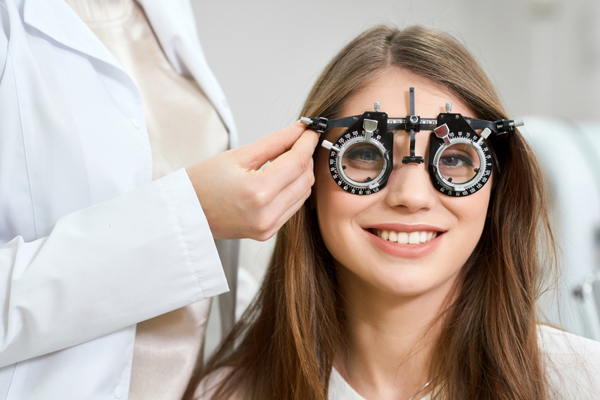What Is Prokera Eye Treatment?

Prokera® is a versatile treatment that stimulates regeneration and healing on the surface of the eyeball. It also doubles as a protective barrier that covers the cornea as it heals. The treatment takes the form of a device that works like a contact lens. Ultimately, Prokera is like a bandage that sits on top of the eye's surface, using contact to perform its healing work.
If you are looking for a holistic treatment option for a long-term eye problem, Prokera is worth exploring. Read on to learn more about this cutting-edge treatment, how it works, and how it can improve your quality of life.
How Prokera works to improve the health of the cornea
Prokera is an appliance that fits right onto the eye, much like a contact lens does. The device consists of an ultra-thin, transparent film of amniotic membrane with a poly-carbonate ring frame.
Amniotic membrane comes from placentas donated by pregnant people who undergo delivery by C-section. The proximity of the membrane to the baby makes it rich in stem cells. In the body, stem cells reverse wear and tear in different tissue types. It is these donor stem cells that stimulate regeneration and healing on the eye's surface.
Eye conditions that improve with Prokera treatment
Prokera treats several conditions that affect the cornea. The device can also act as a protective barrier that keeps moisture in and irritants out. This physical barrier ensures that the cornea heals without further damage from the environment. The treatment treats conditions like:
- Corneal scarring from injury or illness
- Chemical burns
- Exposure keratitis, which is dryness that results from the inability of the eyelid to close completely
The donor tissue for Prokera goes under rigorous testing and quality control to ensure its safety. As such, it delivers an effective, minimally invasive treatment to eye conditions of minor and moderate severity.
What to expect from Prokera treatment
The procedure of placing the Prokera device onto the eye is as straightforward as diagnosis and placement. Wearing the appliance feels like wearing a large contact lens, and the sensation takes a day or two to get used to. Patients who need the treatment for dryness may benefit from having their eyelid partially shut with sutures or tape.
The optometrist will send the patient home with aftercare instructions that include leaving the Prokera device alone. Only the doctor should lift the device from the eye. Doctors often prescribe eye drops and medication to ease the sensation of a foreign object in the eye. Some conditions resolve completely with Prokera as part of treatment. Other situations require periodic therapy with the device.
Frequently asked questions about Prokera treatment
Considering getting Prokera treatment? Here are the answers to some commonly asked questions:
1. Which conditions can be treated with Prokera?
Prokera can be used to treat people with eye disorders like keratitis, partial limbal stem cell deficiency, and corneal defects. It can also be used to heal damage caused by chemical burns, corneal scars, or inflammatory eye disease.
The amniotic membrane used for Prokera treatments has therapeutic properties that help to repair damaged eye surfaces. Eye injuries treated with Prokera tend to have less inflammation and scarring. Prokera treatments typically lead to shorter treatment times as well.
2. How long will I have the Prokera lens in my eye?
It usually takes two to five days for Prokera membranes to dissolve. Patients are evaluated at this point to determine if follow-up treatments are needed to promote healing. Patients typically report improved vision due to their treatment within three to five days.
3. Are Prokera treatments approved by the FDA?
The Food and Drug Administration approves Prokera treatments. It involves using amniotic membranes donated by women who undergo cesarean deliveries. The membranes used go through extensive tests before being cleared for use. Prokera has been used to treat eye injuries for over three decades, and there are no reports of patients having allergic or adverse reactions to the membrane.
These amniotic membranes are used to repair eye injuries by placing them on the surfaces of the patients’ eyes. Prokera treatments also provide relief from discomfort and inflammation in the eye. It ensures there is no scarring as the eye heals.
Restore the health of your eyes with Prokera therapy
Holistic treatments like Prokera can regenerate the eye surface to restore complete form and function. This is a far better alternative to settling for a lifelong eye condition. Get in touch with our practice and find out how this therapy can work for you.
Request an appointment here: https://brighteyesmv.com or call Bright Eyes Optometry at (914) 668-1429 for an appointment in our Mt Vernon office.
Check out what others are saying about our services on Yelp: Prokera in Mt Vernon, NY.
Recent Posts
Emergency eye care is needed if you find yourself dealing with a problem with your eye that causes pain or affects your vision. Failing to treat eye injuries as soon as they are detected can lead to permanent consequences, like reduced vision or blindness. Common eye injuries that require emergency eye care include: Exposure to…
Looking for more information on eye protection? An ophthalmologist knows everything there is to know about protecting the eyes. While there are a few different types of eye care professionals, ophthalmologists are eye care professionals who have undergone additional years of education and training so they can offer their patients both medical and surgical eye…
Controlling myopia at an early age can slow down its progression. This can help prevent yearly upgrades for stronger glasses. Your optometrist can help by offering various treatments. If you want to find out how your optometrist can help control myopia, here are the details.Optometrists use atropine eye drops to achieve short-term myopia control results.…
Another word for an itchy eye is ocular pruritis. It is a common health situation in many people. Itchiness in your eyes is more than enough reason to see an optometrist. Receiving prompt treatment is important in receiving prompt relief. If you want to know what causes an itchy eye and the treatments for it,…



